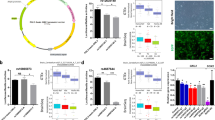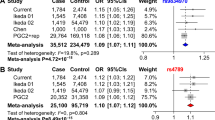Abstract
We previously reported that expression level of LIM (ENH, PDLIM5) was significantly and commonly increased in the brains of patients with bipolar disorder, schizophrenia, and major depression. Expression of LIM was decreased in the lymphoblastoid cells derived from patients with bipolar disorders and schizophrenia. LIM protein reportedly plays an important role in linking protein kinase C with calcium channel. These findings suggested the role of LIM in the pathophysiology of bipolar disorder and schizophrenia. To further investigate the role of LIM in these mental disorders, we performed a replication study of gene expression analysis and performed genetic association studies. Upregulation of LIM was confirmed in the independent sample set obtained from Stanley Array Collection. No effect of sample pH or medication was observed. Genetic association study revealed the association of single nucleotide polymorphism (SNP)1 (rs10008257) with bipolar disorder. In an independent sample set, SNP2 (rs2433320) close to SNP1 was associated with bipolar disorder. In total samples, haplotype of these two SNPs was associated with bipolar disorder. No association was observed in case–control analysis and family-based association analysis in schizophrenia. These results suggest that SNPs in the upstream region of LIM may confer the genetic risk for bipolar disorder.
This is a preview of subscription content, access via your institution
Access options
Subscribe to this journal
Receive 12 print issues and online access
$259.00 per year
only $21.58 per issue
Buy this article
- Purchase on Springer Link
- Instant access to full article PDF
Prices may be subject to local taxes which are calculated during checkout



Similar content being viewed by others
References
Goodwin FK, Jamison KR . Manic-Depressive Illness. Oxford University Press: New York, 1990.
Schulze TG, McMahon FJ . Genetic linkage and association studies in bipolar affective disorder: a time for optimism. Am J Med Genet C Semin Med Genet 2003; 123: 36–47.
Schumacher J, Jamra RA, Freudenberg J, Becker T, Ohlraun S, Otte AC et al. Examination of G72 and D-amino-acid oxidase as genetic risk factors for schizophrenia and bipolar affective disorder. Mol Psychiatr 2004; 9: 203–207.
Hattori E, Liu C, Badner JA, Bonner TI, Christian SL, Maheshwari M et al. Polymorphisms at the G72/G30 gene locus, on 13q33, are associated with bipolar disorder in two independent pedigree series. Am J Hum Genet 2003; 72: 1131–1140.
Chen YS, Akula N, Detera-Wadleigh SD, Schulze TG, Thomas J, Potash JB et al. Findings in an independent sample support an association between bipolar affective disorder and the G72/G30 locus on chromosome 13q33. Mol Psychiatr 2004; 9: 87–92; image 5.
Mirnics K, Middleton FA, Stanwood GD, Lewis DA, Levitt P . Disease-specific changes in regulator of G-protein signaling 4 (RGS4) expression in schizophrenia. Mol Psychiatr 2001; 6: 293–301.
Chowdari KV, Mirnics K, Semwal P, Wood J, Lawrence E, Bhatia T et al. Association and linkage analyses of RGS4 polymorphisms in schizophrenia. Hum Mol Genet 2002; 11: 1373–1380.
Williams NM, Preece A, Spurlock G, Norton N, Williams HJ, McCreadie RG et al. Support for RGS4 as a susceptibility gene for schizophrenia. Biol Psychiatr 2004; 55: 192–195.
Morris DW, Rodgers A, McGhee KA, Schwaiger S, Scully P, Quinn J et al. Confirming RGS4 as a susceptibility gene for schizophrenia. Am J Med Genet 2004; 125B: 50–53.
Chen X, Dunham C, Kendler S, Wang X, O’Neill FA, Walsh D et al. Regulator of G-protein signaling 4 (RGS4) gene is associated with schizophrenia in Irish high density families. Am J Med Genet B Neuropsychiatr Genet 2004; 129B: 23–26.
Iwamoto K, Kakiuchi C, Bundo M, Ikeda K, Kato T . Molecular characterization of bipolar disorder by comparing gene expression profiles of postmortem brains of major mental disorders. Mol Psychiatr 2004; 9: 406–416.
Iwamoto K, Bundo M, Washizuka S, Kakiuchi C, Kato T . Expression of HSPF1 and LIM in the lymphoblastoid cells derived from patients with bipolar disorder and schizophrenia. J Hum Genet 2004; 49: 227–231.
Maeno-Hikichi Y, Chang S, Matsumura K, Lai M, Lin H, Nakagawa N et al. A PKC epsilon-ENH-channel complex specifically modulates N-type Ca2+ channels. Nat Neurosci 2003; 6: 468–475.
Pandey GN, Dwivedi Y, SridharaRao J, Ren X, Janicak PG, Sharma R . Protein kinase C and phospholipase C activity and expression of their specific isozymes is decreased and expression of MARCKS is increased in platelets of bipolar but not in unipolar patients. Neuropsychopharmacology 2002; 26: 216–228.
Soares JC, Mallinger AG . Intracellular phosphatidylinositol pathway abnormalities in bipolar disorder patients. Psychopharmacol Bull 1997; 33: 685–691.
Ueki N, Seki N, Yano K, Masuho Y, Saito T, Muramatsu M . Isolation, tissue expression, and chromosomal assignment of a human LIM protein gene, showing homology to rat enigma homologue (ENH). J Hum Genet 1999; 44: 256–260.
Detera-Wadleigh SD, Badner JA, Yoshikawa T, Sanders AR, Goldin LR, Turner G et al. Initial genome scan of the NIMH genetics initiative bipolar pedigrees: chromosomes 4, 7, 9, 18, 19, 20, and 21q. Am J Med Genet 1997; 74: 254–262.
Mowry BJ, Ewen KR, Nancarrow DJ, Lennon DP, Nertney DA, Jones HL et al. Second stage of a genome scan of schizophrenia: study of five positive regions in an expanded sample. Am J Med Genet 2000; 96: 864–869.
Ginns EI, St Jean P, Philibert RA, Galdzicka M, Damschroder-Williams P, Thiel B et al. A genome-wide search for chromosomal loci linked to mental health wellness in relatives at high risk for bipolar affective disorder among the Old Order Amish. Proc Natl Acad Sci USA 1998; 95: 15531–15536.
Kennedy JL, Basile VS, Macciardi FM . Chromosome 4 Workshop Summary: Sixth World Congress on Psychiatric Genetics, Bonn, Germany, October 6–10, 1998. Am J Med Genet 1999; 88: 224–228.
Blackwood DH, Visscher PM, Muir WJ . Genetic studies of bipolar affective disorder in large families. Br J Psychiatr 2001; 178: S134–S136.
Levinson DF, Mahtani MM, Nancarrow DJ, Brown DM, Kruglyak L, Kirby A et al. Genome scan of schizophrenia. Am J Psychiatr 1998; 155: 741–750.
Paunio T, Tuulio-Henriksson A, Hiekkalinna T, Perola M, Varilo T, Partonen T et al. Search for cognitive trait components of schizophrenia reveals a locus for verbal learning and memory on 4q and for visual working memory on 2q. Hum Mol Genet 2004; 13: 1693–1702.
Paunio T, Ekelund J, Varilo T, Parker A, Hovatta I, Turunen JA et al. Genome-wide scan in a nationwide study sample of schizophrenia families in Finland reveals susceptibility loci on chromosomes 2q and 5q. Hum Mol Genet 2001; 10: 3037–3048.
Sheehan DV, Lecrubier Y, Sheehan KH, Amorim P, Janavs J, Weiller E et al. The Mini-International Neuropsychiatric Interview (M.I.N.I.): the development and validation of a structured diagnostic psychiatric interview for DSM-IV and ICD-10. J Clin Psychiatr 1998; 59(Suppl 20): 22–33; quiz 34–57.
Aoki-Suzuki M, Yamada K, Meerabux J, Iwayama-Shigeno Y, Ohba H, Iwamoto K et al. A family-based association study and gene expression analyses of netrin-G1 and -G2 genes in schizophrenia. Biol Psychiatr 2005; 57: 382–393.
Martin ER, Monks SA, Warren LL, Kaplan NL . A test for linkage and association in general pedigrees: the pedigree disequilibrium test. Am J Hum Genet 2000; 67: 146–154.
Sham PC, Curtis D . An extended transmission/disequilibrium test (TDT) for multi-allele marker loci. Ann Hum Genet 1995; 59: 323–336.
Clayton D, Jones H . Transmission/disequilibrium tests for extended marker haplotypes. Am J Hum Genet 1999; 65: 1161–1169.
Clayton D . A generalization of the transmission/disequilibrium test for uncertain-haplotype transmission. Am J Hum Genet 1999; 65: 1170–1177.
Dudbridge F, Koeleman BP, Todd JA, Clayton DG . Unbiased application of the transmission/disequilibrium test to multilocus haplotypes. Am J Hum Genet 2000; 66: 2009–2012.
Pritchard JK, Stephens M, Donnelly P . Inference of population structure using multilocus genotype data. Genetics 2000; 155: 945–959.
Iwamoto K, Bundo M, Kato T . Altered expression of mitochondria-related genes in postmortem brains of patients with bipolar disorder or schizophrenia, as revealed by large-scale DNA microarray analysis. Hum Mol Genet 2005; 14: 241–253.
Sebat J, Lakshmi B, Troge J, Alexander J, Young J, Lundin P et al. Large-scale copy number polymorphism in the human genome. Science 2004; 305: 525–528.
Kuroda S, Tokunaga C, Kiyohara Y, Higuchi O, Konishi H, Mizuno K et al. Protein-protein interaction of zinc finger LIM domains with protein kinase C. J Biol Chem 1996; 271: 31029–31032.
Wang HY, Friedman E . Enhanced protein kinase C activity and translocation in bipolar affective disorder brains. Biol Psychiatr 1996; 40: 568–575.
Manji HK, Lenox RH . Ziskind-Somerfeld Research Award. Protein kinase C signaling in the brain: molecular transduction of mood stabilization in the treatment of manic-depressive illness. Biol Psychiatr 1999; 46: 1328–1351.
Acknowledgements
Postmortem brain tissue was donated by the Stanley Medical Research Institute's brain collection courtesy of Drs Michael B Knable, E Fuller Torrey, Maree J Webster, Serge Weis, and Robert H Yolken. This study was supported by a grant from the Lab. for Molecular Dynamics of Mental Disorders (T Kato). We thank all the volunteers who participated in this study. We also appreciate the continuous support by the Research Resource Center, RIKEN Brain Science Institute. We are grateful for the valuable discussion to Dr Tadao Arinami (University of Tsukuba).
Author information
Authors and Affiliations
Corresponding author
Rights and permissions
About this article
Cite this article
Kato, T., Iwayama, Y., Kakiuchi, C. et al. Gene expression and association analyses of LIM (PDLIM5) in bipolar disorder and schizophrenia. Mol Psychiatry 10, 1045–1055 (2005). https://doi.org/10.1038/sj.mp.4001719
Received:
Revised:
Accepted:
Published:
Issue Date:
DOI: https://doi.org/10.1038/sj.mp.4001719
Keywords
This article is cited by
-
Bayesian logistic regression in detection of gene–steroid interaction for cancer at PDLIM5 locus
Journal of Genetics (2016)
-
Reduced cortical expression of a newly identified splicing variant of the DLG1 gene in patients with early-onset schizophrenia
Translational Psychiatry (2015)
-
Peripheral PDLIM5 expression in bipolar disorder and the effect of olanzapine administration
BMC Medical Genetics (2012)
-
Prediction of susceptibility to major depression by a model of interactions of multiple functional genetic variants and environmental factors
Molecular Psychiatry (2012)
-
Identification of blood biomarkers for psychosis using convergent functional genomics
Molecular Psychiatry (2011)



